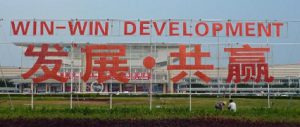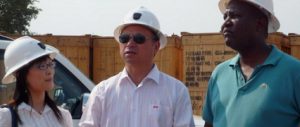Editor’s note: this article concludes a series of commentaries on chinadialogue about environment and development in Africa, with a special focus on the role of China. To read a summary of the arguments in the Global Witness report, see the introductory piece by Sam Geall “China in Africa: deepening the debate”.
The recently released report China and Congo: Friends in Need by the watchdog organisation Global Witness analyses one of the most significant milestones of the emerging superpower’s engagement with the African continent: the US$6 billion Sicomines barter deal struck in 2007 between the government of the Democratic Republic of Congo (DRC) and a consortium of Chinese state-owned and private companies. The report provides a comprehensive overview of the agreement, outlining the context, background, details and controversies of the joint venture.
The report’s critical points are not new: the arguments raised have been brought forward by Congolese opposition and civil society actors, diplomats and international activists since 2007. However, the report synthesises the complex agreement and the debate in a pedagogical manner which has not been done before. Given its weight in the west as a respected campaigning organisation, Global Witness reaches a broad audience. The report, available in English, French and Chinese-language versions, provides readers outside of a narrow expert community with a detailed understanding of the deal, which is a novel and laudable effort.
However, with this authoritative position and the ability to influence opinion comes an analytical and methodological responsibility, which Global Witness does not fully shoulder in this case. While the report’s recommendations are pertinent and the analysis thorough, a few methodological deficiencies leave the reader with a feeling of not having been provided with a full version of this highly complex story.
Field research is always a thorny task, and the DRC is certainly no exception. The Global Witness research team should be commended for having gone to the field to engage with the relevant stakeholders, but some of the avenues pursued to secure access seem to have been fairly unproductive.
There is no doubt that both the Congolese and Chinese stakeholders should share information about the agreement more openly. But it is equally to be expected that a research team with a genuine ambition to understand a case as sensitive as this should have made greater efforts in order to access the stakeholders and the information at hand. The difficulties that the Global Witness team experienced in terms of securing access could be at least partly have been mitigated by pursuing a fine-tuned networking strategy. This compromises the validity of the report’s main claim: the lack of information available around the agreement.
The choice not to include an analysis of the contract amendments, which stipulates what changes the parties agreed to make to the debated original version of the agreement, in a report released 18 months after the third and final amendment was signed raises further methodological question marks. Access to these documents was certainly limited in the early months following their signing, but by now it has been circulated in Kinshasa for a while. An assessment of the amendments would have strengthened Global Witness’s case substantially, given that the contract analysis is such an important part of the report.
Part of the report’s commendable ambition is to inform an audience without expert knowledge. However, such an endeavour requires analytical framing in the form of appropriate background information, and as it stands, readers without an in-depth understanding of the Congolese political environment are left hanging. What is the contextual backdrop for the argument? What is the usual modus operandi in terms of information sharing in the country’s mining sector and in concessional finance-funded infrastructure projects? Is the secrecy around this deal an unfortunate exception or part of common practice?
The planning and pricing of the infrastructure projects certainly are surrounded by opacity, but procedural delays also form a part of the explanation why the details are not clear. The whole portfolio is currently being scrutinised in Beijing by China’s powerful economic planners, the National Development and Reform Commission (NDRC), and it is only once the NDRC has approved of the calculated production capacity of the mine that the disbursement rate of the loans for the infrastructure projects will be determined.
Finally, the absence of Chinese inputs compromises the report’s analytical weight. The above discussed absence of an appropriate networking strategy has resulted in a report which does not account for perceptions and explanations provided by Chinese respondents. The most salient example is the argument furthered by the report that the Chinese party now has very little commercial risk. In our recent interviews, relevant Chinese stakeholders as well as western diplomats have argued that the Chinese party is taking substantial risks with the deal. This is reportedly not purely a calculated move: even the Chinese party admits that their ambition to secure access to the concessions drove them to conclude an agreement in haste without first having conducted more in-depth feasibility studies.
An informed reader would now correctly argue that this risk component is an integral part of all mining ventures, and that the Chinese party has secured the reimbursement of the infrastructure expenses contractually. Indeed, the Chinese party is most likely to come out of the venture with a great deal of profits, but it is still sensitive to the various risks involved with providing such large concessional loans to be reimbursed by means of income from a mining venture in a politically volatile environment.
This is indeed part of the reason why China’s NDRC is now conducting such a thorough assessment of the portfolio before giving the project the final go-ahead. The absence of critical analysis of the insecurity experienced by the Chinese party adds to the impression that the report does not explore all the facets of the case. On the whole, China and Congo: Friends in Need is a welcome contribution that does a very good job in explaining the complexities, controversies and challenges around the Sicomines agreement to a broader audience. But given the methodological deficiencies discussed in this review, but it also needs to be read with a critical eye.
Johanna Jansson is a PhD candidate in international development studies at Roskilde University, Denmark. Jiang Wenran is Mactaggart Research Chair of the China Institute, University of Alberta, Canada. Jansson and Jiang carried out field work in the DRC from February to May, 2011. This article was first published in Fahamu’s Perspectives on Emerging Powers in Africa, March 2011.
Homepage image by FairPhone shows a group of Congolese miners.
Lizzie Parsons from Global Witness has responded to this article. Please read the response here.




![India, Uttarakhand, Haridwar, dam on the Ganga [image: Alamy]](https://dialogue.earth/content/uploads/2020/03/P1YATT-300x200.jpg)

